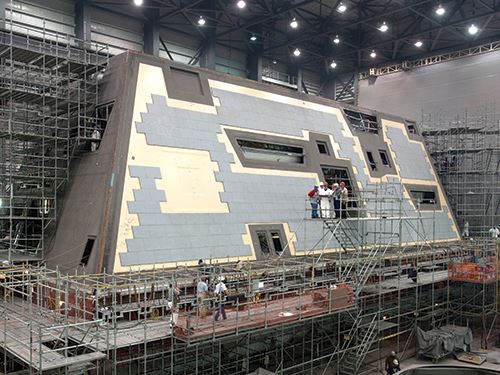Destroyer deckhouse roof meets U.S. Navy fire code with phenolic composite
An all-composite deckhouse superstructure, built by Huntington Ingalls Industries (Gulfport, Miss.) cuts topside weight and enables stealth capability by reducing the radar signature of the U.S. Navy’s new, nearly $4 billion (USD) Zumwalt-class destroyer.
Although the U.S. Navy’s new, nearly $4 billion (USD) Zumwalt-class destroyer has a steel hull, it is topped with an all-composite deckhouse superstructure that cuts topside weight and gives the ship stealth capability by reducing its radar signature. Built by Huntington Ingalls Industries (Gulfport, Miss.), the superstructure features flat sandwich panels of balsa core (Alcan Baltek Corp., Northvale, N.J.) between faceskins of T700 carbon fiber (Toray Composite Materials America, Inc., Flower Mound, Texas) woven by Sigmatex (Benecia, Calif.) and infused with vinyl ester resin from Ashland, LLC (Dublin, Ohio).
The balsa-cored panels offered good fire performance, compared to foam- or honeycomb-cored alternatives, for the majority of the superstructure, but when the Navy expressed concern about the fire-readiness of its roof, more robust fire-resistant panels were developed by phenolic laminate specialist DuraSip LLC (Union, Miss.), a subcontractor to Navy contractor Temeku Technologies Inc. (Herndon, Va.), to meet the Navy’s fire code. DuraSip’s CEO and composites engineer Max Ware says the 2-ft by 2-ft by 1.5-inch thick (0.62m by 0.62m by 34-mm) panels were produced with multi-ply reinforced phenolic skins bonded to rigid phenolic foam under heat and pressure, using a phenolic adhesive. DuraSip used Momentive Specialty Chemicals Inc.’s (Columbus, Ohio) trademarked Cellobond J2027L phenolic resin, supplied through Mektech Composites Inc. (Hillsdale, N.J.). “Fiberglass or carbon fiber-reinforced phenolic laminates maintain structural properties at elevated temperatures better than laminates made with any other thermoset resin,” he comments. “Also, they give off the least amount of toxic gasses compared to other thermosets, so the phenolic panels were the right choice.” They also act as thermal insulators, to help keep the deckhouse interior at a comfortable temperature.
The roof panels, totaling 6,000 ft2/557m2, were bonded to the deckhouse with either adhesives or mechanical fasteners, and the phenolic laminate surfaces received a weatherproof coating after assembly.
Related Content
-
The potential for thermoplastic composite nacelles
Collins Aerospace draws on global team, decades of experience to demonstrate large, curved AFP and welded structures for the next generation of aircraft.
-
Plant tour: Teijin Carbon America Inc., Greenwood, S.C., U.S.
In 2018, Teijin broke ground on a facility that is reportedly the largest capacity carbon fiber line currently in existence. The line has been fully functional for nearly two years and has plenty of room for expansion.
-
The lessons behind OceanGate
Carbon fiber composites faced much criticism in the wake of the OceanGate submersible accident. CW’s publisher Jeff Sloan explains that it’s not that simple.


















